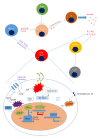The pathology of T cells in systemic lupus erythematosus
- PMID: 24864268
- PMCID: PMC4017881
- DOI: 10.1155/2014/419029
The pathology of T cells in systemic lupus erythematosus
Abstract
Systemic lupus erythematosus (SLE) is characterized by the production of a wide array of autoantibodies. Thus, the condition was traditionally classified as a "B-cell disease". Compelling evidence has however shown that without the assistance of the helper T lymphocytes, it is indeed difficult for the "helpless" B cells to become functional enough to trigger SLE-related inflammation. T cells have been recognized to be crucial in the pathogenicity of SLE through their capabilities to communicate with and offer enormous help to B cells for driving autoantibody production. Recently, a number of phenotypic and functional alterations which increase the propensity to trigger lupus-related inflammation have been identified in lupus T cells. Here, potential mechanisms involving alterations in T-cell receptor expressions, postreceptor downstream signalling, epigenetics, and oxidative stress which favour activation of lupus T cells will be discussed. Additionally, how regulatory CD4+, CD8+, and γδ T cells tune down lupus-related inflammation will be highlighted. Lastly, while currently available outcomes of clinical trials evaluating therapeutic agents which manipulate the T cells such as calcineurin inhibitors indicate that they are at least as efficacious and safe as conventional immunosuppressants in treating lupus glomerulonephritis, larger clinical trials are undoubtedly required to validate these as-yet favourable findings.
Figures

References
-
- Tsokos GC. Mechanisms of disease: systemic lupus erythematosus. The New England Journal of Medicine. 2011;365(22):2110–2121. - PubMed
-
- Shlomchik MJ, Craft JE, Mamula MJ. From T to B and back again: positive feedback in systemic autoimmune disease. Nature Reviews Immunology. 2001;1(2):147–153. - PubMed
-
- Crispín JC, Kyttaris VC, Juang Y-T, Tsokos GC. How signaling and gene transcription aberrations dictate the systemic lupus erythematosus T cell phenotype. Trends in Immunology. 2008;29(3):110–115. - PubMed
Publication types
MeSH terms
Substances
LinkOut - more resources
Full Text Sources
Other Literature Sources
Medical
Research Materials

